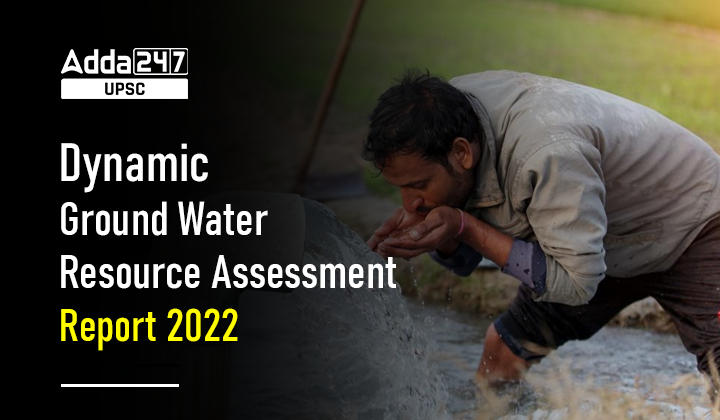Table of Contents
About Dynamic Ground Water Resource Assessment Report 2022
- Dynamic Ground Water Resource Assessment Report 2022 is in line with the plan of the union government to carry out nationwide assessments annually to determine the groundwater scenario in the country.
- Dynamic Ground Water Resource Assessment Report 2022 indicates an increase in country’s groundwater recharge which may mainly be attributed to an increase in recharge from canal seepage, return flow of irrigation water and recharges from water bodies/tanks & water conservation structures.
Why in news and why important for UPSC?
- Union Minister of Jal Shakti, Gajendra Singh Shekhawat released the Dynamic Ground Water Resource Assessment Report for the entire country for the year 2022 in New Delhi yesterday.
- The assessment was carried out jointly by Central Ground Water Board (CGWB), States and Union Territories.
- Such joint exercises between CGWB & States/UTs were carried out earlier in 1980, 1995, 2004, 2009, 2011, 2013, 2017, and 2020.
Ground Water is the backbone of India’s Water Security
- Ground water has steadily emerged as the backbone of India’s agriculture and drinking water security.
- Contribution of ground water is nearly 62% in irrigation, 85% in rural water supply and 50% in urban water supply.
- Ground water is an annually replenishable resource but its availability is non-uniform in space and time.
- Ground water available in the zone of water level fluctuation is replenished annually with rainfall being the dominant contributor.

National Water Policy, 2012 on periodic assessment of groundwater
- National Water Policy, 2012 has laid emphasis on periodic assessment of ground water resources on scientific basis.
- The trends in water availability due to various factors including climate change must also be assessed and accounted for during water resources planning.
- To meet the increasing demands of water, it advocates direct use of rainfall, desalination and avoidance of inadvertent evapotranspiration for augmenting utilizable water resources.
- The National Water Policy 2012 also states that safe water for drinking and sanitation should be considered as pre-emptive needs followed by high priority allocation for other domestic needs (including needs of animals), achieving food security, supporting sustenance agriculture and minimum eco- system needs.
- Available water, after meeting the above needs should be allocated in a manner to promote its conservation and efficientuse.
Methodology of estimating Ground water resources
- Ground water resource as in 2022 have been estimated following the guidelines mentioned in the GEC 2015 methodology using appropriate assumptions depending on data availability.
- The methodology recommends aquifer wise ground water resource assessment of both the Groundwater resources components, i.e., Replenishable ground water resources or Dynamic Ground Water Resources and In-storage Resources or Static Resources.
- Wherever the aquifer geometry has not been firmly established for the unconfined aquifer, the in-storage ground water resources have to be assessed in the alluvial areas down to the depth of bed rock or 300 m, whichever is less.
- In case of hard rock aquifers, the depth of assessment would be limited to 100 m.
- In case of confined aquifers, if it is known that groundwater extraction is being done from this aquifer, the dynamic as well as in-storage resources are to be estimated.
Key data from Dynamic Ground Water Resource Assessment Report 2022
- The assessment indicates an increase in groundwater recharge.
- Analysis indicates improvement in groundwater conditions in 909 assessment units in the country compared with 2017 assessment data.
- The total annual groundwater recharge for the entire country is 437.60 billion cubic meters (BCM).
- Annual groundwater extraction for the entire country is 239.16 BCM.
- Out of total 7089 assessment units, 1006 units were categorized as ‘Over-exploited’.
What is the main source of groundwater resources?
- The main source of replenishable ground water resources is recharge from rainfall, which contributes to nearly 61 % of the total annual ground water recharge.
- India receives about 119 cm. of rain annually on average, with high spatial variation.
- A major part of the country receives rainfall mainly during SW Monsoon season, spread over the months of June to September, except in Tamil Nadu, where the major contribution is from NE monsoon during the period October– December.
- There are also States such as Jammu and Kashmir, Himachal Pradesh and Uttarakhand which receive significant rainfall in all seasons.
How types of rock formations influence groundwater recharge?
- Type of rock formations and their storage and transmission characteristics have a significant influence on ground water recharge.
- Porous formations such as the alluvial formations in the IndoGanga-Brahmaputra basin generally have high specific yields and are good repositories of ground water.
- Ground water occurrence in the fissured formations occupying nearly two-thirds of the geographical area of the country, on the other hand, is mostly limited to the weathered, jointed and fractured portions of the rocks.
Dynamic Ground Water Resource Assessment Report 2022: FAQs
Q. In which years earlier were Dynamic Ground Water Resource Assessment exercises done?
Ans: Such joint exercises between CGWB & States/UTs were carried out earlier in 1980, 1995, 2004, 2009, 2011, 2013, 2017, and 2020.
Q. Who prepared Dynamic Ground Water Resource Assessment Report 2022?
Ans: The assessment was carried out jointly by Central Ground Water Board (CGWB), States and Union Territories.
Q. What is the main source of groundwater resources?
Ans: The main source of replenishable ground water resources is recharge from rainfall, which contributes to nearly 61 % of the total annual ground water recharge.
Analysis Of Kurukshetra Magazine July 2022: ”Jal Shakti Abhiyan”



 TSPSC Group 1 Question Paper 2024, Downl...
TSPSC Group 1 Question Paper 2024, Downl...
 TSPSC Group 1 Answer key 2024 Out, Downl...
TSPSC Group 1 Answer key 2024 Out, Downl...
 UPSC Prelims 2024 Question Paper, Downlo...
UPSC Prelims 2024 Question Paper, Downlo...
